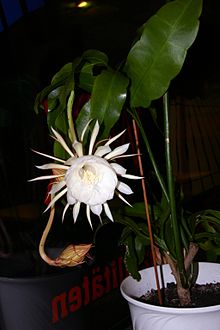Epiphyllum
| Epiphyllum | |
|---|---|

| |
| Epiphyllum oxypetalum | |
| Scientific classification | |
| Kingdom: | Plantae |
| Clade: | Tracheophytes |
| Clade: | Angiosperms |
| Clade: | Eudicots |
| Order: | Caryophyllales |
| Family: | Cactaceae |
| Subfamily: | Cactoideae |
| Tribe: | Hylocereeae |
| Genus: | Epiphyllum Haw. |
| Type species | |
| Epiphyllum phyllanthus (L.) Haw.[1] | |
| Species | |
| Synonyms[2] | |
Epiphyllum (/ˌɛpɪˈfɪləm/;[3] "upon the leaf" in Greek) is a genus of epiphytic plants in the cactus family (Cactaceae), native to Central America and South America. Common names for these species include climbing cacti, orchid cacti and leaf cacti, though the latter also refers to the genus Pereskia.
Description
[edit]The stems are broad and flat, 1–5 cm broad, 3–5 mm thick, usually with lobed edges. The flowers are large, 8–16 cm diameter, white through red, with numerous petals. Flowers bloom only at night, and wilt at dawn. The fruit is edible, very similar to the pitaya fruit from the closely related genus Hylocereus, though not so large, being only 3–4 cm long. The broad-leaved epiphyllum (Epiphyllum oxypetalum) is particularly well-known. It bears large, strongly fragrant flowers that each usually open for a single night only.
Taxonomy
[edit]It was published by Adrian Hardy Haworth in 1812.[4][5] The type species is Epiphyllum phyllanthus (L.) Haw.[1]
Species
[edit]As of May 2020[update], Plants of the World Online accepts 10 species:[2]
| Image | Scientific name | Distribution |
|---|---|---|
 |
Epiphyllum baueri Dorsch | Colombia, Panama |
| Epiphyllum cartagense (F.A.C.Weber) Britton & Rose | Costa Rica, Panama | |
 |
Epiphyllum chrysocardium Alexander | Mexico |
| Epiphyllum grandilobum (F.A.C.Weber) Britton & Rose | Costa Rica, Nicaragua, Panama | |
 |
Epiphyllum hookeri Haw. | Mexico, Central America, Venezuela; introduced to Florida |
 |
Epiphyllum laui Kimnach | Mexico |
 |
Epiphyllum oxypetalum (DC.) Haw. | Belize, Honduras, El Salvador, Mexico |
 |
Epiphyllum phyllanthus (L.) Haw. | Mexico to Venezuela then south to Argentina |
 |
Epiphyllum pumilum Britton & Rose | Guatemala, Mexico |
 |
Epiphyllum thomasianum (K.Schum.) Britton & Rose | Costa Rica, Ecuador, Guatemala, Nicaragua |
Formerly placed here
[edit]- Disocactus crenatus (Lindl.) M.Á.Cruz & S.Arias (as Epiphyllum crenatum (Lindl.) G.Don)
- Disocactus lepidocarpus (F.A.C.Weber) M.Á.Cruz & S.Arias (as Epiphyllum lepidocarpum (F.A.C.Weber) Britton & Rose)
- Disocactus phyllanthoides (DC.) Barthlott (as E. phyllanthoides (DC.) Sweet[6])
Cultivation
[edit]The plants known as epiphyllum hybrids, epiphyllums or just epis, which are widely grown for their flowers, are artificial hybrids of species within the tribe Hylocereeae, particularly species of Disocactus. In spite of the common name, the involvement of Epiphyllum species as parents of Epiphyllum hybrids is unconfirmed.[7][8]
References
[edit]- ^ a b Epiphyllum Haw. (n.d.). International Plant Names Index. Retrieved January 27, 2025, from https://www.ipni.org/n/30002688-2
- ^ a b "Epiphyllum Haw". Plants of the World Online. Royal Botanic Gardens, Kew. Retrieved 2020-05-15.
- ^ Sunset Western Garden Book, 1995:606–607
- ^ Haworth, Adrian Hardy. (1812). Synopsis plantarum succulentarum :cum descriptionibus, synonymis, locis, observationibus anglicanis, culturaque (p. 197). Typis R. Taylor et Socii. https://www.biodiversitylibrary.org/page/10003997
- ^ Missouri Botanical Garden. (n.d.-j). Epiphyllum Haw. Tropicos. Retrieved January 27, 2025, from https://www.tropicos.org/name/40004308
- ^ "GRIN Species Records of Epiphyllum". Germplasm Resources Information Network. United States Department of Agriculture. Archived from the original on 2012-12-12. Retrieved 2011-04-14.
- ^ Van der Meer, M. H. J. (2018-12-31). "16 new nothogenera and 15 new combinations in Hylocereeae (Cactaceae)". Cactologia Phantastica. 1: 1–16.
- ^ Worsley, A. (1907). "Hybrids among the Amarylliae and Cactaceae, with some notes on variation in the Gesneriaceae and the genus Senecio". In Wilks, W. (ed.). Report of the Third International Conference 1906 on Genetics. London: Spottiswoode & Co. p. 407.
External links
[edit]- Epi Species (GotEpis.com), a comprehensive list of genera of epiphytic cacti.
